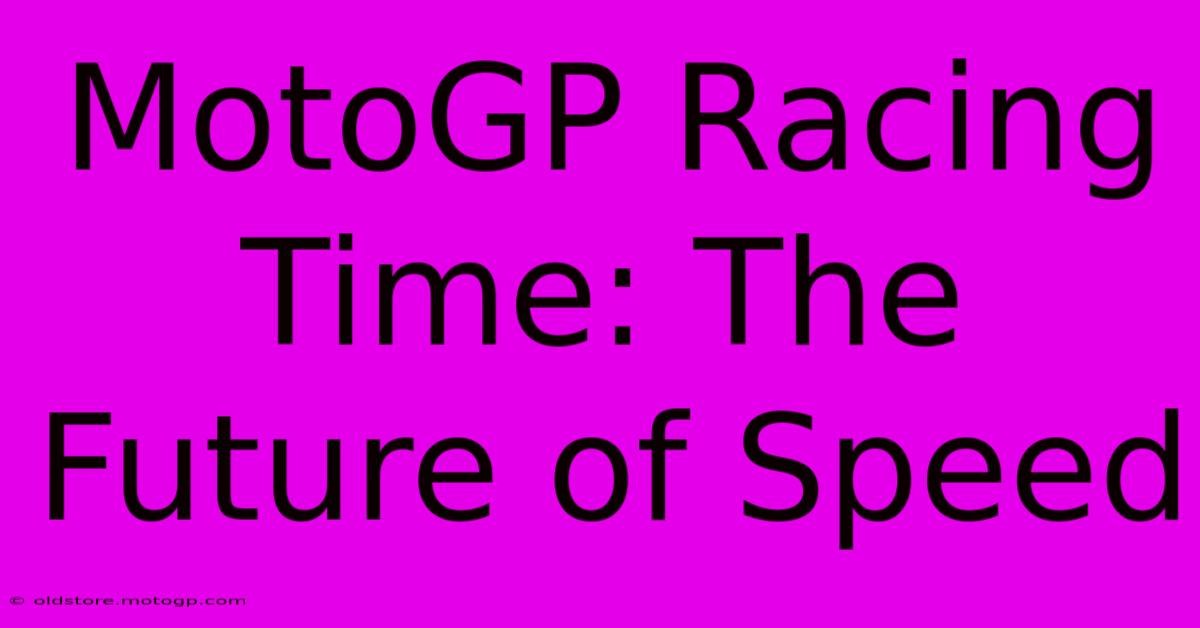MotoGP Racing Time: The Future Of Speed

Table of Contents
MotoGP Racing Time: The Future of Speed
MotoGP, the pinnacle of motorcycle racing, is a relentless pursuit of speed. Every season witnesses advancements in technology, rider skill, and race strategies, pushing the boundaries of what's possible on two wheels. But what does the future hold for MotoGP racing time? Will we see lap records shattered consistently, or are there inherent limits to how fast these machines can go? This exploration delves into the factors influencing MotoGP's future speed and the potential for even more breathtaking racing.
The Ever-Evolving Machine
The heart of MotoGP's speed lies in its machinery. Manufacturers like Ducati, Yamaha, Honda, Aprilia, and KTM are in a constant arms race, striving for marginal gains in engine power, aerodynamic efficiency, and chassis dynamics.
Engine Technology:
- Increased Horsepower: We've already seen significant increases in horsepower over the years. Future developments in engine technology, potentially including even more sophisticated electronics and materials science, could unlock further power gains.
- Improved Fuel Efficiency: Ironically, stricter fuel regulations might paradoxically lead to faster lap times. Teams will be forced to develop more efficient engines, resulting in lighter, more responsive machines.
- Hybrid Powertrains? While still speculative, the introduction of hybrid powertrains in the future isn't entirely out of the question. This could revolutionize MotoGP, offering bursts of extra power while potentially improving fuel consumption.
Aerodynamics:
- Sophisticated Winglets and Fairings: Aerodynamic advancements are crucial for high-speed stability and cornering. Expect to see even more refined winglets and fairings, maximizing downforce and reducing drag.
- Computational Fluid Dynamics (CFD): Advanced simulations will play an increasingly important role in optimizing aerodynamics, leading to smaller, more efficient designs.
Tire Technology:
Tire technology is another critical factor. Michelin's current tires are already incredibly advanced, but further development in grip, consistency, and durability will undoubtedly contribute to faster lap times.
The Human Element: Rider Skill and Training
While technology plays a dominant role, the human element remains crucial. MotoGP riders are elite athletes, constantly pushing their physical and mental limits.
Enhanced Rider Training:
- Data Analysis and Simulation: Advanced data analysis tools allow riders to meticulously study their performance, identify areas for improvement, and optimize their riding style. Simulators further enhance their training and allow them to practice in various conditions.
- Physical Fitness and Conditioning: MotoGP riders require exceptional levels of physical fitness and stamina. Continuous advancements in training methods and sports science will undoubtedly improve their performance on the track.
Track Evolution and Race Strategies
The racing tracks themselves and the strategies employed during races also impact lap times.
Track Modifications:
- Resurfacing and Redesign: Track resurfacing and even minor redesigns can significantly impact lap times, often leading to faster overall race speeds.
- Runoff Areas and Safety: Increased safety measures, while crucial, can sometimes indirectly affect lap times by requiring less cautious lines through corners.
Race Strategies:
- Tire Management and Pit Stops: Advanced tire management strategies and refined pit stop procedures will continue to influence race results and overall times.
The Limits of Speed: A Balancing Act
Despite the ongoing technological advancements, there are inherent limits to how fast MotoGP bikes can go. Safety concerns, the physical limitations of riders, and the challenges of maintaining bike stability at extreme speeds all act as constraints.
Conclusion: A Thrilling Future
The future of MotoGP racing time is likely to be characterized by incremental improvements rather than revolutionary leaps. However, the combination of ongoing technological advancements, enhanced rider training, and evolving race strategies promises a thrilling future for the sport, with ever-faster lap times and even more breathtaking races to come. The quest for speed in MotoGP is a constant evolution, a captivating blend of human skill and technological prowess, pushing the limits of what's possible on two wheels.

Thank you for visiting our website wich cover about MotoGP Racing Time: The Future Of Speed. We hope the information provided has been useful to you. Feel free to contact us if you have any questions or need further assistance. See you next time and dont miss to bookmark.
Featured Posts
-
Dont Miss Out Moto Gp Racing Time Is Approaching
Feb 23, 2025
-
Cota Parking Lot T Avoid The Long Walks
Feb 23, 2025
-
F1 Event Houston Your Vip Experience Awaits
Feb 23, 2025
-
F1 Us Grand Prix Uninterrupted Tv Coverage Guaranteed
Feb 23, 2025
-
Cota Motorcycle Track Days Invest In Your Riding
Feb 23, 2025
